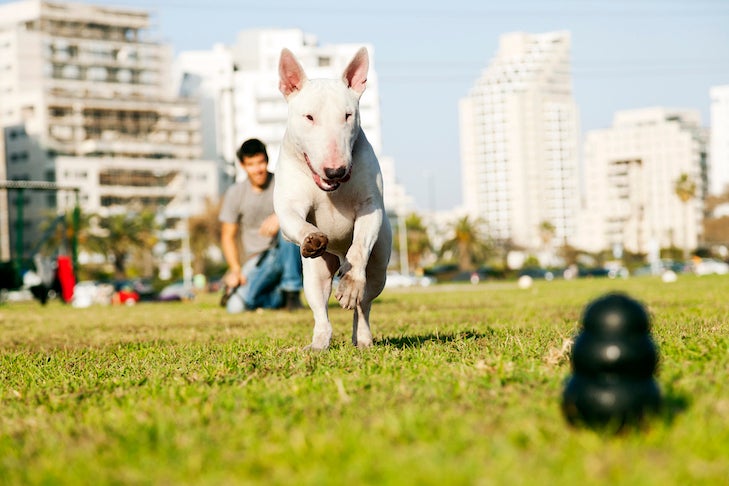Similar to people, sensitive, anxious, or reactive dogs can have periods when everything seems to go wrong. Trigger stacking refers to a phenomenon in which a dog experiences multiple stressful or scary situations within a short timespan. As a result, a pup may feel overwhelmed and exhibit a large reaction to an otherwise minor stressor. Here’s how to tell when your dog is battling trigger stacking and how to help them deal with it.
What is Trigger Stacking in Dogs?
Because dogs thrive on routine, they might feel rattled when their schedules are disrupted. That even goes for pets who don’t generally experience ongoing anxiety or reactivity. As part of a stressed dog’s fight-or-flight response, cortisol—the body’s natural stress hormone—is released. This increase in cortisol might result in your dog responding in a manner that is out of character to a seemingly minor situation. Such anxious behavior might manifest as lunging, snapping, growling, or even biting.
Different things will stress different dogs, and a pup’s feelings about an unpleasant or concerning situation might differ from day to day. On a calm day, your dog might ignore a person coming to the door. When your dog is at their comfort level, they are said to be “below threshold.”

In another day, though, perhaps they experience a series of successive triggers, such as vet visits, meeting barking canines, and then a doorbell ringing. In response to the ringing doorbell, a final stimulus that pushes them over the anxiety threshold, your dog might suddenly bark at the sound. When your dog gets anxious or reacts to distractions, your pet has gone “over threshold.” At this point, their stress levels will build and they won’t be able to focus on you.
How to Avoid Trigger Stacking
Think of your dog as an individual, rather than comparing them to other pups, when you try understand their triggers. “Flooding” in dog training refers to dogs being repeatedly exposed to triggers over a short period of time, often intentionally. Trigger stacking happens when dogs experience triggers back-to-back without having an opportunity to recover from previous stimuli.

Flooding your dog won’t actually change behavior with desensitization or shift their overall response. In fact, forcing your dog into stressful situations might worsen canine fears and phobias or reactivity. When training, aim to keep your “under threshold.” Over time, you can work through this via counter conditioning and slowly pairing the sight, smell, or presence of a stressor with a non-stressor from a comfortable distance.
Deal with a Dog Above Threshold
Unfortunately, even if you have great plans to keep your dog below threshold, sometimes life gets in the way. We might not have a choice other than to push forward through the moment quickly and keep our dog as calm as possible.
In those moments, take the lead by advocating for your dog. Ask people to give your pet space or if you can exit out the back. If no other option exists, shorten your leash to keep your dog safely close to you; pull out the treats and lure or guide your dog through the space. Avoid lingering and instead try to get your pet out of the stressful situation as quickly as possible. Since dogs don’t dwell on the past, proactively treat this experience as a learning opportunity for the future.
Allow Recovery Time
If your dog experiences an incident of trigger stacking, try to give them time to decompress. It takes time for their cortisol levels to drop. Some pups can compose themselves quickly after such a situation, while others can carry stress effects for days or even longer. If possible, let your dog take a break somewhere quiet, where they can enjoy a chew or food-stuffed hard toy or take a nap. Or try foraging activities, such as letting your pup search for treats you’ve thrown for them.

Take your next training sessions slowly, giving your dog more space and distance from triggers. Reward calm behavior at that distance before attempting to train your dog to bring them closer to the stressor. Even if your dog previously was able to train at a closer location, begin working again at a larger distance after they experience trigger stacking.
If you are feeling uncertain about which situations your pup finds stressful or overwhelmed by your dog’s responses, ask for help. An experienced positive reinforcement trainer can help you understand canine stress signals and also support you in developing a training plan to avoid future trigger stacking incidents.

